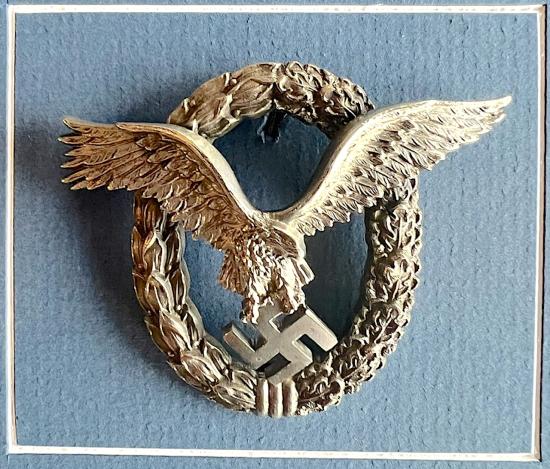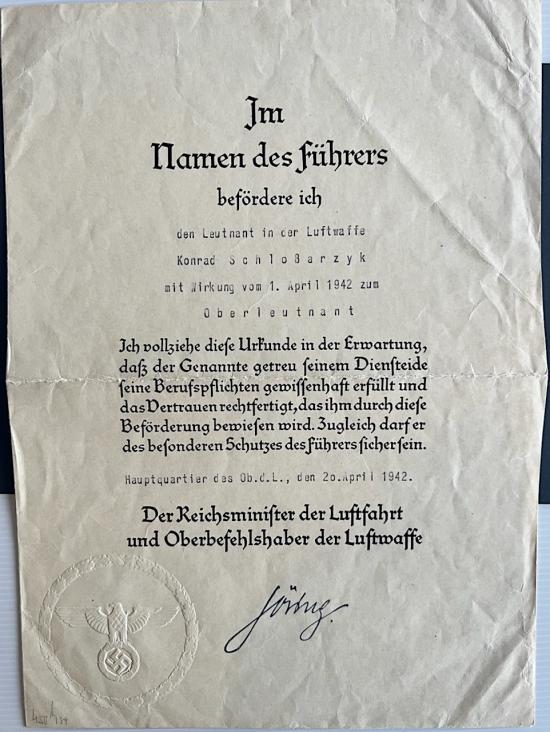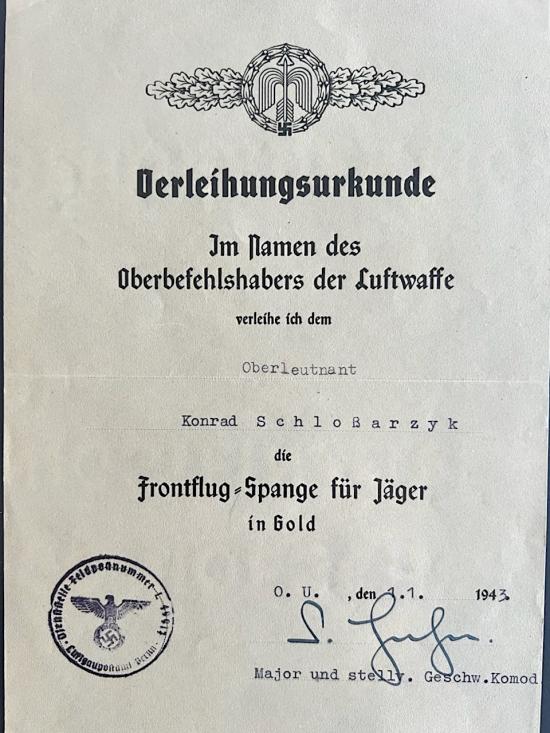WW2 GERMAN LUFTWAFFE BATTLE OF BRITAIN/LONDON BLITZ BOMBER AND LATER FIGHTER PILOT GROUP TO OBERLEUTEUTNANT KONRAD SCHLOSSARZYK
German WW2 Battle of Britain/London Blitz Heinkel Pilot later Messerschmitt Bf 109 Fighter Pilot Oberleutnant Konrad Schloßarzyk.
Luftwaffe Pilots Grouping to Battle of Britain and London Blitz Heinkel Pilot and Messerschmitt BF 109 Fighter Pilot Oberleutnant Konrad Paul Schloßarzyk.C359:C384.
This is an extremely well-documented Second War Luftwaffe Pilot’s group awarded to Oberleutnant Konrad Paul Schloßarzyk, a HE 111 bomber pilot of KG1 during ‘The Blitz’, who bombed London at least a dozen times and also took part in Operation Moonlight Serenade, the devastating raid on Coventry in November 1940.
Retraining as a fighter pilot, Schloßarzyk flew ME109s with JG3 and JG5 on the Finnish Russian Front in Finland, racking up some 128 combat missions by 12 March 1943, and was killed whilst serving as a flying instructor during the American bombing on Halberstadt Airfield on 30 May 1944.
His entire combat history is recorded in his original Luftwaffe Flying Logbooks included with the Group.
The Group also includes: Luftwaffe Pilot’s Badge (an original replacement for the display) maker’s mark ‘JMME’ for Imme & Sohn, Berlin, with original pin, hook and hinge as well as his original Pilot’s Badge, this in relic condition the Swastika detached from the Eagle and the Eagle detached from the wreath.
Luftwaffe Day Fighter Clasp in Silver, unmarked, awarded for 60 or more Operational Flights.
Luftwaffe Day Fighter Clasp in Gold, maker’s mark ‘R.S. and S.’ (Richard Simm and Sohn, Gablonz), awarded for 100 or more Operational Flights.
Black Wound Badge (an original replacement for the display) and his original Wound Badge in black, this also in relic condition lacking retaining pin.
Eastern Winter Medal (Ostmedaille).
Third Reich Iron Cross First Class breast badge, silver with iron centre, with screwback suspension, the reverse stamped ‘L/13’ for Paul Meybauer, Berlin.
Second Class Iron Cross breast badge, silver with iron centre, unmarked.
War Merit Cross 1939, Second Class, with swords, bronze.
Konrad Paul Schloßarzyk was born in Leipzig on 30 October 1918 and joined the Luftwaffe as an Oberfahnrich in early 1939, making his first training flight (FW44) on 3 April. His first solo flight followed on 8 May - this being his 61st flight (HE72) - and after that he continued training on several aircraft types, with his first flight as pilot of a HE 111 bomber on 23 February 1940. He soon after qualified for his Pilot’s badge on 8 March 1940. He was promoted Leutnant on 1 April 1940, gaining his night flying certificate on 1 June 1940. Continuing his training and familiarisation flights throughout 1940, he crash-landed his HE 111 in France during a flight from Rosières to Gutersloh on 9 August 1940. Service as a Heinkel HE 111 Pilot during the Battle of Britain.
Schloßarzyk became operational when posted to Stab1/KG1 (Kampfgeschwader “Hindenberg”) based at Montdidier, in France in September 1940. Piloting Heinkel HE 111h series medium bombers during the early stages of the ‘The Blitz’, he was awarded both the Iron Cross Second and First Classes for his service.
During the Blitz, he took part in night attacks on London on 29 September 1940 (his 1st combat mission), and subsequently further night attacks on 11, 13, 14, 15, 26, and 28 October, and on 1, 5, 6, 15 and 16 November.
He also took part in daylight attacks on London on 7 and 10 November 1940, and night attacks on Coventry on 14 and 19 November, the latter being his 16th combat mission. Service as a Messerschmitt BF 109 Fighter Pilot: Schloßarzyk was subsequently posted back to Germany for training on fighter aircraft, taking his first fight in a Messerschmitt BF 109d on 28 January 1941. By October 1941 he had transferred to Luftwaffe Northern (Arctic) detachment and was based at Stavanger, Sola, in Norway, with Luftflotte 5 - probably Luftgaukdo Norwegen Stab 13/JG 77 flying a Messerschmitt Bf 109 day fighter. He then moved to Alakurtti, Finland, on the Verman Defence Line, as part of Luftflotte 5, just north of the Arctic Circle.Schloßarzyk took part in his 60th combat mission on 4 March 1942 (qualifying for his Silver Day Fighter clasp) and was promoted Oberleutnant on 1 April 1942. Posted to Petsamo, a port on the Northern Lapland coast on the Arctic Ocean, and just 40 miles from Russian Murmansk, he then moved between Kirkenes, Norway and Petsamo, Finland, where on the 11 September he made his 100th combat mission. Flying from various airfields in Norway and Finland over the following months, on 23 February 1943 he flew his 110th combat mission (qualifying for his Gold Day Fighter clasp). On 1 March 1943, flying a BF 109F-4 with II/JG-5, he suffered a post-operational landing crash at Alakurtti airfield, but was back flying two days later and on 12 March he completed his 128th and final combat mission.
Schloßarzyk was back in Germany by the beginning of May 1943, based at Halberstadt, Sachsen-Anhalt, where he became a flying instructor at the Luftkriegsschule III Oschatz, making a further 477 instructional flights. On 30 May 1944, U.S. 8th Airforce bombed the Junkers Aircraft Plant and Airfield at Halberstadt. During the U.S. bombing, a direct hit on an air-raid shelter killed the complete staff of 2 Inspektion Luftkriegsschule III, comprising five Luftwaffe officers, plus two soldiers and the wife of one of the airfield’s senior officers. Schloßarzyk was one of the officers in the shelter at this time and was killed. At the time of his death, he had recorded 1597 flights.
The Group also comes with the following documentary archive: The recipient’s two original Luftwaffe Flying Logbooks, detailing his entire flying service from training until death. Original certificates for the recipient’s Pilots badge, dated 8 March 1940; Iron Cross Second Class, dated 24 October 1940; Iron Cross First Class dated 13 November 1940; Fighter operational flying clasp in Silver, dated 8 March 1942; Fighter operational flying clasp in Gold, dated 1 January 1943; and Ostmedaille, dated 15 November 1942. Commission documents for Leutnant and Oberleutnant. Two identity documents with his photographs. A U.S.A.F. leaflet dropped circa 1944, offering German soldiers safe conduct if they surrender. Approximately 30 original photographs, including portraits of Schloßarzyk and his aircraft, including those he crashed and others.
Code: 50854
19800.00 NZD










